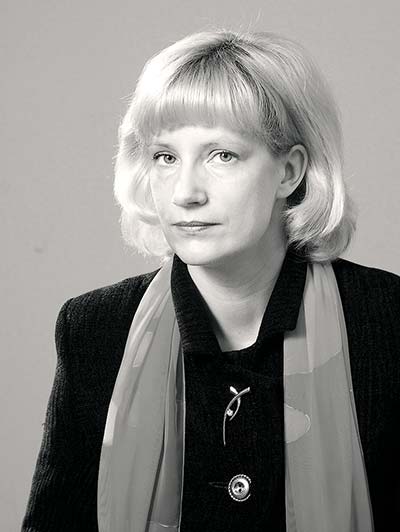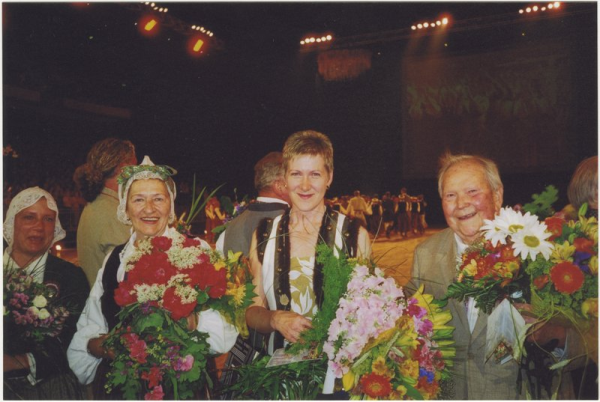Arta Melnalksne
1968–2013
Choreographer, dance educator
Arta Melnalksne (Mazitāne) was born 8 August 1968 in Rīga. Studied at Rīga’s No 2 Secondary School (now Rīga No 2 State High School).
Has been dancing since the age of four – first in the Zelta sietiņš (Golden Sieve) folk-dance group with Baiba Šteina (1974–1985), also in the Rīga No 2 Secondary School dance group under Gunārs Cekuls-Strods, in the Daile (Beauty) State folk-dance ensemble dance studio (1985–1987) and the Vektors People’s Folk-dance ensemble. In 1992, graduated from the Jāzeps Vītols Academy of Music, Department of Choreography with a bachelor’s degree in choreography and a qualification as a dance teacher and dance-group director. Obtained a Master’s degree from the Dramatic Art department of the Latvian Academy of Culture (2006).
Since 1986, has been the artistic director and choreographer of the Skabardzēni Rīga Teika Secondary School dance group and since 1990, artistic director and choreographer of the Zalktis (Grass Snake) young people’s dance group. Through her emotion- and love-filled lifetime, Melnalksne has nurtured more than 500 dancers.
Has created the choreography for, directed and staged a series of choreographic performances and dance suites, composing more than 350 dances and 11 dance performances. In Melnalksne’s original works, the most important features are the values of Latvian folk wisdom, love of God, nature and people. Her dances are based on Latvian folkloric traditions, drawing on the knowledge in the Folkloric Collection archives of the Latvian Academy of Sciences. They are distinguished by their originality, display the primeval power of dance, approaching a historical interpretation of dance – the pirmdeja (dance precursor). Many of them have been included in Dance-celebration repertoires and won prizes in new-dance competitions, such as Tēva nav mājās (Father’s Not Home, 2001), Lai pēla pēlējiņi (Let Them Blame Me), Burkāniņi, kāpostiņi (Carrots, Cabbages, 2001), Krustamātes krakovjaks or Es ar savu krustamāti (Godmother’s Krakoviak or My Godmother and I), Es noaudu zvaigžņu segu (I Wove a Blanket of Stars), Ko man dosi Liela diena? (What Have You for Me, First Day of Spring?). She has also created splendid choreographic performances and concert programmes, including Precības (Marriage, 1999), Pierobežā dzīvojami (Life on the Border, 2000) and Kad tēva nav mājās (When Father Isn’t Home, 2001), which have also been presented at international festivals in Latvia, Estonia, Lithuania, Denmark, Slovakia, the Czech Republic, Hungary, Poland, Austria, Italy, Sweden, and Turkey.
As early as at the 1998 Dance Celebration, the artist was entrusted with the production of the Es nemiršu šai zemē (I Will not Die in this Land) segment of the Solis laikā (Step in Time) concert. She was first nominated as a Chief choreographer for the 8th Latvian Schools’ Song and Dance Celebration (2000). Subsequently, festival followed upon festival – Latvian Schools’ Song and Dance Celebrations, All-Latvian Song and Dance Celebrations, Rīga Children’s and Young People’s Dance Celebrations, various festivals, concerts and master classes.
Has initiated a wonderful and significant tradition in Rīga’s dance space – founding the Rīga educational institutions’ dance festival. This is the first major festival specifically for the dancers of Rīga educational institutions. The 1st Rīga Educational Institution Dance Festival – Lai visiem mājas ir! (May Everyone Have a Home! 2007) – attracted more than 3 000 dancers, but the 2nd – Deja tek pa celiņu (Dance Flows Along the Way, 2011) – 261 groups with 4 174 dancers.
A Chief choreographer at the 13th and 14th Dance Celebrations, Rīga-800 Festival and 8th Latvian Young People’s Song and Dance Celebration.
Received the Ministry of Culture Prize in Folk Art (1999).





